Back to
Contents - Previous - Next
July 7 - Tallinn
Click a picture to see a
larger view.

Every cruise of
sufficient length surprises with an unexpected gem. Tallinn, Estonia
was this one’s.
 First we learned about the
uniqueness of Estonia.
The people migrated from central Asia long,
long ago, so their heritage is distinct from their neighbors. The closest
affinity they have is to the Fins. Their language is close enough to Finnish
that they understand visiting Finns and
First we learned about the
uniqueness of Estonia.
The people migrated from central Asia long,
long ago, so their heritage is distinct from their neighbors. The closest
affinity they have is to the Fins. Their language is close enough to Finnish
that they understand visiting Finns and  Finns visit a lot. Finland
is less than two hours away by hydrofoil and Fins come here to shop since
prices here are a bargain. Oddly,
Finnish products like their cheese cost less in Estonia
than in Finland
where it is produced. Our tour guide, who has lived in Estonia many
years, said that the Fins use to come to get drunk, but now come to shop.
Finns visit a lot. Finland
is less than two hours away by hydrofoil and Fins come here to shop since
prices here are a bargain. Oddly,
Finnish products like their cheese cost less in Estonia
than in Finland
where it is produced. Our tour guide, who has lived in Estonia many
years, said that the Fins use to come to get drunk, but now come to shop.
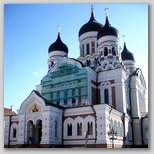
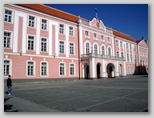 What the Estonian’s do not
like are things Russian. Estonia
was controlled by Russia for
many years up to the fall of the Soviet Union.
Russia is a huge country
with very limited access to the sea and Estonia provided a wide stretch of
coast for them. That is evidence during the preparations for the 1980 Olympics.
Russia resorted to
building a facility for the yacht
competition near Tallinn.
A large Russian Orthodox church was built directly across from the Estonian
parliament building. The tour guide said “it was too large to move,” depicting
the common attitude for anything Russian.
What the Estonian’s do not
like are things Russian. Estonia
was controlled by Russia for
many years up to the fall of the Soviet Union.
Russia is a huge country
with very limited access to the sea and Estonia provided a wide stretch of
coast for them. That is evidence during the preparations for the 1980 Olympics.
Russia resorted to
building a facility for the yacht
competition near Tallinn.
A large Russian Orthodox church was built directly across from the Estonian
parliament building. The tour guide said “it was too large to move,” depicting
the common attitude for anything Russian.
Estonia
is a very small country. It has 1.5
million inhabitants, 400,000 of whom live in Tallinn. But the city seems larger when one
is downtown among its modern office buildings and hotels. Fortunately the
Stalin school of architecture had limited reach into Tallinn. The buildings take their place as
equals to the other modern cities of the Baltic that we visited. The few things
Soviet stick out like sore thumbs with the crumbling concrete façade as the
typical giveaway.
However, the crown jewel of Tallinn is its old town, which we heard was
the most complete medieval town anywhere. The city wall built in the twelfth
century surround the city and many buildings date back to the time Columbus
headed to the new world. It is a delight to walk the cobblestone streets and
admire the variety of pastel painted buildings. Many were the homes of rich
merchants and others the guild houses of merchant trades. They are now
embassies, government buildings, shops, and restaurants.
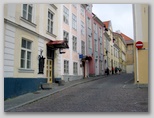


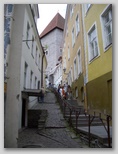
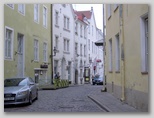
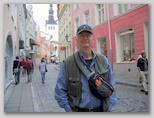
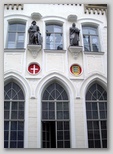
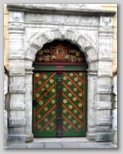

Several of these shops sell amber in the form of necklaces,
broaches, and other jewelry. We found that eight percent of all the amber in
the world comes from the Baltic region. But the best shopping was the market in
the town square. Every town square in this part of the world has stalls and
merchants, but in Tallinn,
many of the goods were made by the merchant selling it. Wearing a variety of
native costumes, the market was a festive craft show.
 You will quickly learn
that few Estonians speak English. Unlike other countries we visited on this
trip, you will have to do a bit of gesticulation to make a purchase here.
However, we successfully did so with one merchant and Ellen now has a beautiful
linen wrap handmade by a talented Tallinn
woman.
You will quickly learn
that few Estonians speak English. Unlike other countries we visited on this
trip, you will have to do a bit of gesticulation to make a purchase here.
However, we successfully did so with one merchant and Ellen now has a beautiful
linen wrap handmade by a talented Tallinn
woman.
After visiting opulent Russian Orthodox churches of St.
Petersburg, we saw a couple of the simplistic interiors of the predominant
churches of Estonia,
Lutheran. Martin Luther railed against the excesses of the Church and these
churches are definitely more modest. The masses of Russia later railed against the
excesses of the Russian Orthodox church, among other things, with a more
radical solution: close them down and make atheism the official state religion.
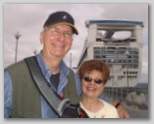 In one of the churches, an
organist entertained us with a short program of religious music, with fine solo
vocal accompaniment. The interior of the church was decorated by a series of
paintings depicting stories of the bible. Our guide reminded us that most
people were illiterate in those days and relied on pictures for the stories
told in the Bible.
In one of the churches, an
organist entertained us with a short program of religious music, with fine solo
vocal accompaniment. The interior of the church was decorated by a series of
paintings depicting stories of the bible. Our guide reminded us that most
people were illiterate in those days and relied on pictures for the stories
told in the Bible.
We were in port
of Tallinn for just a few
hours and the time left us wanting to spend more time in this delightful Baltic
town.
 First we learned about the
uniqueness of
First we learned about the
uniqueness of  Finns visit a lot.
Finns visit a lot. 
 What the Estonian’s do not
like are things Russian.
What the Estonian’s do not
like are things Russian.  You will quickly learn
that few Estonians speak English. Unlike other countries we visited on this
trip, you will have to do a bit of gesticulation to make a purchase here.
However, we successfully did so with one merchant and Ellen now has a beautiful
linen wrap handmade by a talented
You will quickly learn
that few Estonians speak English. Unlike other countries we visited on this
trip, you will have to do a bit of gesticulation to make a purchase here.
However, we successfully did so with one merchant and Ellen now has a beautiful
linen wrap handmade by a talented  In one of the churches, an
organist entertained us with a short program of religious music, with fine solo
vocal accompaniment. The interior of the church was decorated by a series of
paintings depicting stories of the bible. Our guide reminded us that most
people were illiterate in those days and relied on pictures for the stories
told in the Bible.
In one of the churches, an
organist entertained us with a short program of religious music, with fine solo
vocal accompaniment. The interior of the church was decorated by a series of
paintings depicting stories of the bible. Our guide reminded us that most
people were illiterate in those days and relied on pictures for the stories
told in the Bible.








